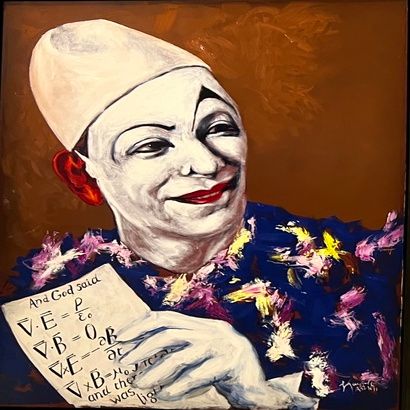Gérard Garouste in Pompidou Museum
Iconography is the representation of a subject.
Iconology, literally the "science of images", is schematically the message they are likely to convey.
But before delving into these explanations, let's return to a few key points about Gérard Garouste:
Now 76 years old, Garouste studied at the Beaux-arts de Paris from 1965 to 1972 in the studio of Gustave Singier.
Initially a creator of humorous drawings and stage designs for his friend Jean Michel Ribes, it was his encounter with Jean Dubuffet and works of art brut that decided him to turn to figurative painting in the late 1970s.
His first exhibition was at the Durand-dessert gallery, then he quickly exhibited internationally, represented by the merchant Léo Castelli.
The institutional recognition comes to complete this course at the end of the 80s, exposed in Bordeaux, at the Cartier Foundation, and answering many public orders, for decorations at the Elysée or sculptures in the cathedral of Evry, or the curtain of stage of the theater of Châtelet and many other achievements still.
Let us also note that the painter founded, in 1991, The Source, an association of education and training for disadvantaged youth.
But let's get back to the exhibition.
When I arrived at the exhibition, one thing jumped out at me: the symbolism or rather the symbol.
I thought of Irwin Panofsky and his iconological essays, written in 1967, a work that had fascinated me at the time.
Panovsky founded the history of art, at the time dominated by psychological, physiological and aesthetic explanations, or reduced to a rather naive iconographic description, as a science of interpretation.
He tried to follow the metamorphoses of ancient traditions: time, love, death or the genesis of the world. These are all strange and learned little odysseys, whose episodes consist of fusions and confusions of concepts and images, misunderstandings, forgetting, resurrections and rebirths of all kinds.
And suddenly here is that the enigma of a work is solved: the artistic chemistry gave to the theme a new sense.
This is where we return to our iconographic and iconological approach to Gérard Garouste. From the image to the idea.
But first, let's go back to the origin: the artist.
This exhibition of 120 paintings is certainly a dedication of his life, but not only.
The publication of his autobiographical account in 2009 "l'Intranquille" allows us to better understand the meaning of his paintings, powerful, and shouting the truth of the artist.
Indeed, Garouste reveals the weight of his family history: an anti-Semitic father condemned in 1945 to pay back the Levithan establishments that he had despoiled in 1943. Some of the paintings recall Garouste's memories of his violent father and mother.
In short, Garouste sees in all this family history the origin of his mental disorders, having spent several stays in psychiatric hospitals, notably in his youth in Villejuif or Saint Anne.
If I give you these different facts, this allows you to understand the approach of the artist who paints expressing what he is in his deepest being and which exceeds him most of the time, which makes him an artist in his own right, to express something else.
Mythology and allegory have occupied an important place from the beginning of his career and this is what interests us today.
Garouste's paintings often refer to the Bible, which occupies an essential place in his life since he studied it intensely while learning Hebrew in the late 1990s.
Garouste paints his life directly on canvas, through the vehicle of myths. As you can see, this is exactly what I was talking about earlier in my talk about iconography and iconology.
But to what end? Even he could not answer this question.
There is nothing repressed in Garouste's work - his self-delusions are entirely conscious.
His work is full of gaps and connections of meaning, of associations of ideas.
I found Garouste's paintings fascinating, often filled with an intelligent humor, where the iconography gives way to an iconology that goes beyond the rather simplistic explanations of the exhibition's cartouches, but this is just me.
This exhibition also highlights the artist's progression very well:
The mythology that holds an important place in the composition of his great paintings or the great stories from which he draws his inspiration as the Divine Comedy of Dante to the supreme initiation through the study of the Talmud
Elodie Couturier, expertisez.com
expertisez youtube


